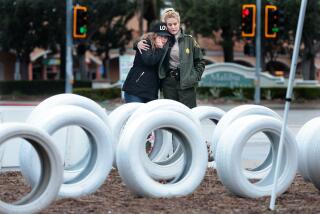State’s Traffic Deaths Fall to 38-Year Low
- Share via
SACRAMENTO — Defying predictions that higher speed limits would mean more carnage, the number of deaths on California’s highways dropped in 1997 to the lowest level in 38 years, state officials reported Monday.
The California Highway Patrol reported that 3,671 people died on streets, highways and freeways last year, a drop of almost 2,000 from the all-time high of 5,503 in 1979.
The lowest number of deaths since 1959 came despite a more than threefold increase in the number of vehicles traveling state roads and a doubling of the state population during the same time period.
A major factor in the steady decline, said CHP Commissioner Dwight O. Helmick, was the corresponding falloff in highway deaths attributed to drinking and driving.
Alcohol-related car crashes killed 1,100 people and injured 19,917 last year, the lowest number in each category in more than a decade, according to Highway Patrol records.
“Thousands of Californians are alive and well today because motorists made decisions not to drink and drive,” Helmick said. “Enforcement and education have paid off.”
The record for alcohol-related traffic deaths was 2,425 in 1987. Injuries caused by drinking and driving reached a peak of 48,173 in 1980, more than double the number recorded last year.
Crackdown on Drunk Drivers
Faster speeds on state freeways, which went into effect in December 1995, did not lead to more accidents as some predicted when speed limits were raised from 55 mph to 65 mph and to 70 mph in some, mostly rural, areas.
Helmick said the state’s highways were engineered to handle the higher speeds. Cars that are easier to control and built to protect occupants during impacts also kept the number of fatalities and injuries down.
“That’s why we advocated raising the limits,” Helmick said.
The crackdown on drinking and driving, on the other hand, has clearly had a major impact on highway carnage. Since the 1980s, the state has made it tougher on violators, increasing penalties for driving under the influence and, in 1990, declaring that a blood alcohol content of 0.08% constituted drunk driving. The previous limit was 0.10%.
Those changes were major factors in reducing crashes, injuries and deaths, said Linda Oxenreider, the state chairwoman of Mothers Against Drunk Driving, who said the organization was “very pleased” with Monday’s statistics.
“We are hopeful that drinking and driving are going the way of smoking cigarettes,” Oxenreider said, “where it just is not acceptable anymore. To put someone who is impaired behind the wheel of a 4,000-pound weapon is unacceptable.”
The last time there were fewer deaths on state roads, California had a population of 15.5 million, less than half the 32 million people who live here now. The 7.4 million vehicles on the road in 1959 multiplied to more than 26.5 million vehicles in 1996, the latest year calculated from state data.
Other factors that contributed to the drop in highway deaths include California’s mandatory seat belt law, which enjoys a compliance rate of 90%, “the highest in the nation,” Helmick said. The high use and increased attention to the importance of child restraints also has helped hold auto deaths and injuries down.
Cars are built safer these days, too, said a spokesman for a major auto maker.
John Clinard of Ford said dual air bags are fairly common now and more recently side air bags have been added in some models to cushion occupants during a collision.
He said that recent safety technology allows cars to be built so that during a crash the force of the impact is distributed around the passenger compartment to other parts of the vehicle.
“The energy of a crash is absorbed in the fender, for example, and not in the passenger area itself,” Clinard said.
Helmick also said the CHP has improved its enforcement, which he said has contributed to the decline.
Other techniques are in the works. CHP cruisersare experimenting with the use of radar to catch speeders on two major freeways, Interstate 5 around Sacramento and Interstate 15 between Barstow and the Nevada line, he said.
Instead of familiar black and white cruisers with easily spotted emergency lights strung across the top of the roof, about 60 Highway Patrol cruisers on the road in undisclosed locations are plain white, with lower profile vehicles and police gear that is not readily visible.
“They’re there to watch truck traffic, mainly,” said Helmick. “But don’t assume they aren’t watching other traffic, too.”
More people are slowing when they should, more drivers are stopping at red lights and more are aware that basic courtesy may be in their self-interest, Helmick said.
“There are still a lot of hotheads out there,” he said, “and when the media reports the road rage, we like it” because it reminds drivers that anger on the road does not pay.
The publicity, he said, “has been helpful to us.”
(BEGIN TEXT OF INFOBOX / INFOGRAPHIC)
Decline in Traffic Deaths
The number of people who died on California’s highways in 1997 was the lowest in 38 years and almost 2,000 fewer than 1979’s all-time high. One factor has been a sharp fall-off in deaths attributed to drinking and driving.
*
Traffic fatalities
Number killed in auto accidents
All: 3,671 died in traffic accidents
Alcohol-related incidents*: 1,100 deaths involved alcohol.
* Figures prior to 1977 were not available.
Source: California Highway Patrol
More to Read
Sign up for Essential California
The most important California stories and recommendations in your inbox every morning.
You may occasionally receive promotional content from the Los Angeles Times.









